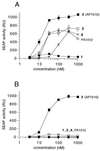A versatile synthetic dimerizer for the regulation of protein-protein interactions
- PMID: 9380684
- PMCID: PMC23423
- DOI: 10.1073/pnas.94.20.10618
A versatile synthetic dimerizer for the regulation of protein-protein interactions
Abstract
The use of low molecular weight organic compounds to induce dimerization or oligomerization of engineered proteins has wide-ranging utility in biological research as well as in gene and cell therapies. Chemically induced dimerization can be used to activate intracellular signal transduction pathways or to control the activity of a bipartite transcription factor. Dimerizer systems based on the natural products cyclosporin, FK506, rapamycin, and coumermycin have been described. However, owing to the complexity of these compounds, adjusting their binding or pharmacological properties by chemical modification is difficult. We have investigated several families of readily prepared, totally synthetic, cell-permeable dimerizers composed of ligands for human FKBP12. These molecules have significantly reduced complexity and greater adaptability than natural product dimers. We report here the efficacies of several of these new synthetic compounds in regulating two types of protein dimerization events inside engineered cells--induction of apoptosis through dimerization of engineered Fas proteins and regulation of transcription through dimerization of transcription factor fusion proteins. One dimerizer in particular, AP1510, proved to be exceptionally potent and versatile in all experimental contexts tested.
Figures






References
-
- Austin D J, Crabtree G R, Schreiber S L. Chem Biol. 1994;1:131–136. - PubMed
-
- Spencer D M. Trends Genet. 1996;12:181–187. - PubMed
-
- Spencer D M, Wandless T J, Schreiber S L, Crabtree G R. Science. 1993;262:1019–1024. - PubMed
-
- Spencer D M, Belshaw P J, Chen L, Ho S N, Randazzo F, Crabtree G R, Schreiber S L. Curr Biol. 1996;6:839–847. - PubMed
MeSH terms
Substances
LinkOut - more resources
Full Text Sources
Other Literature Sources
Research Materials
Miscellaneous

